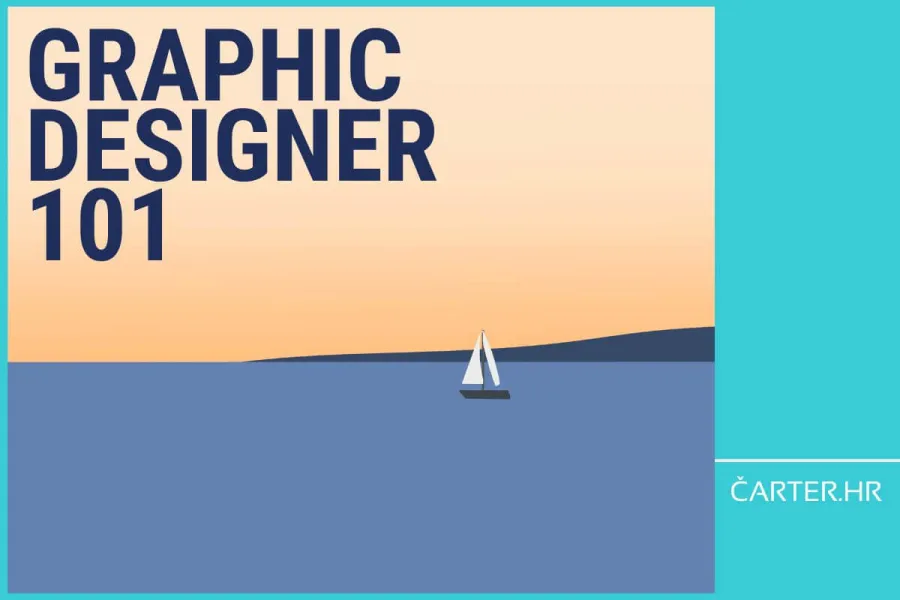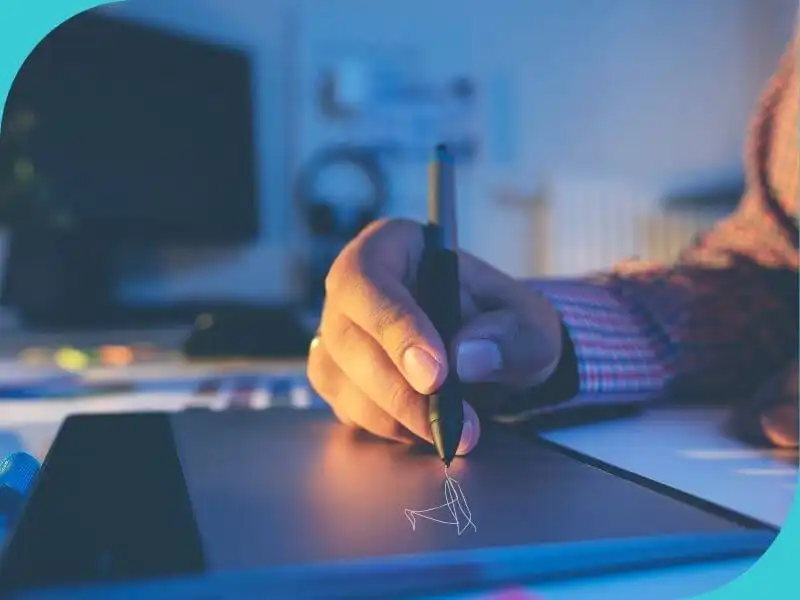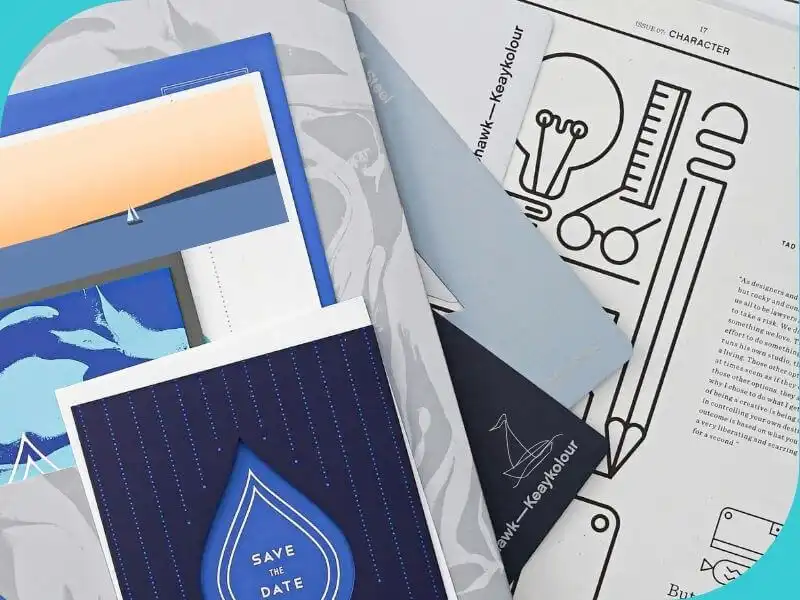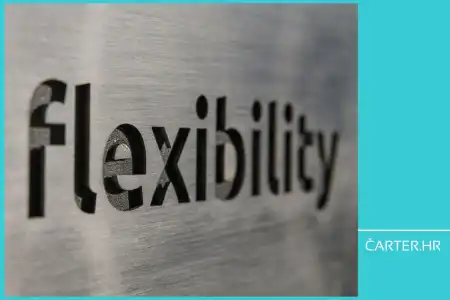
What does the daily life of a graphic designer look like? What exactly falls under their job description - and what doesn’t? Barbara Zec, a designer with over 20 years of experience, in her new original article for čarter.hr reveals what it truly means to be a visual communications designer. From tools and skills to real-world challenges this profession brings - everything is explained firsthand and with clarity.
I have written about graphic design before. In the previous article, you can find out what graphic design is, why it is important for every business, and how the collaboration with a designer unfolds from the first conversation to the final design solution. Now, even though the first rule of design and marketing is to be results- and client-oriented, we must not overlook the person producing those results - the graphic designer. What exactly is the job of a graphic designer? What do they do, and what don’t they do? What tools do they use? What skills must they have? Answers to these and a few other questions follow.
Given that I have been working in graphic design and visual communications for over two decades, I will share with you firsthand what I believe you need to know about it. Because no one told me - I had to learn along the way. I believe designers of my generation would confirm the same. Back then, this type of design was still in its infancy in our region and fairly closed off, so it wasn’t surprising when people assumed I was a fashion designer, even though I had nothing to do with that field. Even job classifications at the time would lump us in with architects or similar professions.
Today, the situation is different because all industries increasingly rely on designers, as it has become evident that branding is one of the most important segments in building a business.
Why has graphic design, alongside branding, become so crucial? We can first look for the answer in biology... About 90% of information is received through our eyes. The first thing we notice about someone is how they look. When we describe something or someone, we usually start with the image. With size, shape, and color. So it’s no surprise that visual communication, i.e. graphic design, is by far the most dominant when we talk about businesses and brands. There are other forms of branding and marketing communication, such as sound branding or scent branding, but they are used sparingly. Again, it’s no wonder - images remain in a space for weeks, months, years, even centuries. For example, we don’t know how the ancient Sumerians or Egyptians sounded, but we certainly know what their art looked like - their walls, frescoes, and mosaics. Sound and scent have long been forgotten, and we can only speculate about them.
Various design solutions, such as visual identities or posters, don’t just appear out of nowhere, as a casual reader of daily and weekly news might assume. That’s because article authors tend to highlight who commissioned the work and who attended the public presentation, but regularly "forget" to mention the creator of the work - unless it’s one of the biggest names that impress the client and whose contracts explicitly require it. Behind all those creations that will later enable the recognition and development of a brand usually stand people we collectively call graphic designers.
Who were the first graphic designers?
The term “graphic designer” was first used by William Addison Dwiggins in 1922 to describe what he actually did. He was an expert in all the disciplines that make up graphic design: typography, illustration, book design, calligraphy, layout, advertising, information design... and he needed a title that would unite all those roles and save him the trouble and time whenever someone asked him: “And what do you do?”
Since it is an interdisciplinary field, every graphic designer has different interests and levels of knowledge, aside from the basic ones they must have to be a good graphic designer, which I will mention later. At its core, graphic design is based on the principles of visual art, but it is not as open to interpretation since it serves a specific function. That’s why the first graphic designers were painters, but also people with a technical background, such as those involved in various applied arts, and often even architects. Formal education and the title of graphic designer came later. What’s more important for our story about the graphic designer are the designers themselves, so it’s only right to mention a few of the most well-known names.
From the older generation, the essential names are Saul Bass, Paul Rand, and Milton Glaser. Bass is best known for film posters and title sequences, Rand is the author of some of the most famous logos and visual identities such as IBM, UPS, the infamous Enron, and ABC, the American television and radio network. Milton Glaser is the author of the famous I(heart)NY logo and the logo for DC Comics. He also worked with one of our most renowned designers (based in New York), Mirko Ilić. Currently, the most prominent designers on the global level are Stefan Sagmeister, Jessica Walsh, and Paula Scher. And from Croatia, the unavoidable names are Davor Bruketa and Nikola Žinić, as well as Boris Ljubičić.

What does a graphic designer do?
The job of a graphic designer is to develop visual concepts. In other words, the job of a graphic designer is to translate verbal ideas into a visual, pictorial language. Or, one of the countless definitions of design that I personally prefer, says that the job of a designer is to solve a problem. Which problem and in what way depends on the tools and the medium in which the designer works. For a graphic designer, these are print and digital media.
Here I want to make a small digression, considering that the job of a graphic designer is changing with the arrival of new tools and media, so the term graphic designer now sounds somewhat archaic because it is based on creating printed materials (i.e. using graphic techniques). Today, communication takes place not only through print media but also through digital media, and the designer often works on the same campaign designing materials for both digital and print media at the same time, meaning they are engaged in visual communication regardless of the medium. So a more accurate term would be - visual communications designer. (For example, when I enrolled in university, the program was called graphic design, but by the time I graduated, it had been renamed to visual communications design. Yes, things in design develop that fast.)
It’s quite difficult to answer the question of what a graphic designer actually does. Mr. Dwiggins from the beginning of the story faced the same issue, which is why he coined the term. Imagine how he’d feel today! I won’t even try to answer briefly, I’ll just start listing final products and see how far I get: logo, brand guidelines, icons, business card, letterhead, envelope, folder, stamp, label, box, bags, various types of packaging regardless of material, graphics for cars, interior, exterior, totems and signage, signage (indoor and outdoor), price list, menu, planner, notebooks, books, picture books, magazines, daily and weekly newspapers, monographs, leaflets, brochures, sales catalogs, wallpapers, posters, citylights, billboards, tarps and awnings, materials for trade shows and exhibitions, ads... in short, applications and design for all possible printed materials. And with the rise of social media and digital media, digital ads also came into play, both animated and static, profile pictures and various covers, graphics for social media, different banners, website layouts, and so on, and so on... I even designed holograms, for example.
Considering the truly enormous range of possibilities, it is unrealistic to expect that in one person - as we often see today in various job ads for graphic designers - you will get an equally skilled typographer, illustrator, brand designer, and then also an animator and web designer; today we have more distinct disciplines, and so some designers focus on social media, or branding, or packaging, or advertising. It all depends on the niche and personal interests. I describe myself as a curious generalist because I love working on projects from start to finish, for example, a full trade show presentation (from digital announcement to booth and gifts), but even I steer clear of, for instance, web design.
What doesn’t a graphic designer do?
Let me go back to the beginning and repeat that a graphic designer translates verbal ideas into a visual language. What does that actually mean? In order for a designer to create a visual solution, they must have answers to certain questions as well as prepared materials and guidelines to work with. They don’t create out of thin air or guesswork.
First of all, they must know exactly what they are creating. If they are designing a logo, they need to know the exact name of the brand or company. If they are working on a key visual for a campaign, they must at the very least know what the largest print format used in the campaign will be. If they are designing a poster, they must receive all the information that will appear on the poster from the client. Who, when, where, how can people get there, what is the price. Furthermore, if there are sponsors that must be listed on the poster, they need to be provided with their logos in vector format. Also, the designer must receive your logo and brand book (which colors and typography you use, and everything else previously defined) so they can create a solution proposal that aligns with your brand and all so-called good design practices. Without this data and these materials, they cannot do their job.
Working without this information would be like walking into a restaurant and ordering lunch by just saying, “I need lunch.” What kind of lunch, what do you want to eat, meat, fish, vegetables? Is there anything you can’t eat, any allergies? How long are you willing to wait for lunch, how much are you willing to pay? How many people will be eating? When?... You get the point. You need to come to the graphic designer prepared, with material or an idea, and definitely not with a “this is urgent” deadline, but open to answering questions and delivering the agreed materials within the agreed timeframe.
I mean, you can also come unprepared and “urgent,” but in that case, be ready to listen and pay the price.
Another important point, which even many designers forget, is that a designer is not an artist. Both use visual elements to create a composition, but a composition created by an artist does not have to carry an unambiguous meaning. It can be intimate, express the artist’s emotions, and each viewer can interpret it in their own way. Unlike an artist, a designer, at the client’s request, uses similar tools to communicate with the audience and convey a very specific message. Buy, watch, join…

Which tools does a graphic designer use?
When people talk superficially about graphic design, they usually assume that design is the result of software. If I had 1 euro for every time someone approached me saying, “I would’ve done it myself but I don’t have Photoshop,” I’d easily have, off the top of my head, at least 15 euros.
Photoshop is just a tool. It is also part of the holy trinity that is essential if you want to pursue graphic design professionally. The other two “must-have” software programs are Illustrator and InDesign. With these three tools, you can design everything listed above. These programs are part of Adobe Creative Cloud, which also includes various specialized programs for animation and video production, among others. Adobe is a monopolist because all marketing agencies use it, and you must have compatible software if you want to work with them. Alternatives for some things include CorelDRAW or Affinity programs. Less demanding graphics can also be created in Canva and Figma, among others.
So, a designer must be skilled in using graphic design software. And not just skilled - because the point is not “excellent software handling” but rather that knowing the tools is the foundation for truly being able to design what they want, instead of being limited by weak software knowledge. This phenomenon becomes apparent when, for example, you ask a designer to create something that you know already exists, and they say, “It can’t be done.” If it already exists, it can be done - the question is “just” one of knowledge, time, and money.
When I say they are just tools, I mean that graphic design, i.e. visual communications design, can (and sometimes must) be done in any software. For example, when I started working, neither InDesign nor Illustrator existed - only Photoshop - and for layouts, we used Freehand or QuarkXPress and some other programs that are now forgotten. Just like typists moved from typewriters with black ribbons to digital keyboards and then to computers, graphic designers have moved on from collaging, copying, constructing letters, and inking by hand to better and more advanced programs and tools. What remains constant for designers is that they must constantly learn. Adapt. And that is only possible if they have deeply ingrained, unchangeable foundations.
In order to arrange all those elements in software in such a way that they first attract the viewer and then lead to the conclusion or action intended by the material, a graphic designer must have the basic principles of design and the basic elements of design at their fingertips. Without understanding these fundamentals, there is no good and functional design. I will definitely address them next time.
What skills must a graphic designer have?
Like any other profession, graphic design stands on three pillars. These are knowledge, methods, and tools. All three are equally important. I mentioned tools in the previous paragraphs, methods are acquired and refined over years of experience and vary depending on whether the graphic designer works in a team, for example in a marketing agency, or works independently. That’s why I will now focus on knowledge and skills.
I’ve already mentioned the basic principles and elements of design. These together serve the visual composition, meaning that each element, shape, or color - whether it’s text, image, or line - has a known meaning. The designer must consciously work with concepts that the viewer instinctively feels. The most basic example: something that is larger is more important. These principles are based on human biology and psychology. Of course, this is a generalization.
Because, as I’ve already said, graphic design is interdisciplinary. This means that in order for the final design solution to be functional, the designer must have a wide range of knowledge. So, in order to know how to compose something, they use knowledge of software and the basic principles and elements, but they also need to understand the culture in which they work, human psychology, sociology, ergonomics, the history of art and typography, photography, illustration, calligraphy, chemistry... They must also know different printing techniques and the characteristics of various materials and colors; they need to be familiar with the requirements of specific media, for example when submitting an ad to a magazine or formatting it for various digital platforms or media... With each new day and every new trend, the field a designer must understand expands, and they must stay up to date. They are “doomed” to lifelong learning. So, being curious doesn’t hurt.

(Visual) communications designer
A beginner designer, especially if working as a junior in a larger team and has someone to learn from (which I recommend to anyone considering a career in graphic design), must have at least some command of the software and basic knowledge of visual principles and design. The rest will be learned along the way. However, as they move up the ranks, some skills that were not so important in the beginning become essential. Especially if they start working independently. One of those skills is communication.
A designer must be a skilled communicator. That’s why I prefer the term visual communications designer over graphic designer. Because in order for a design to fulfill its purpose, the designer must be able to communicate the idea. First visually, but then also verbally. It’s no coincidence that we say “a picture is worth a thousand words,” but it’s just as easy for the viewer to interpret something different from what the designer intended. That’s why the image must be confirmed verbally as well. By asking questions and listening to get answers. That’s why, before starting work on a new campaign or visual identity, questions are first asked, then moodboards or ideas are presented and discussed. Only after that does the graphic designer, in collaboration with the client, arrive at the final solution.
In recent years, the importance of written communication has often been emphasized, so it doesn’t hurt to know how to write and structure thoughts on paper or on a screen. Whether it’s presenting a design solution (although I always recommend presenting in person), writing a social media post, or writing an article like this. But again, it depends on personal interest. I navigate this quite confidently, so if I’ve missed anything or if you have any questions related to the topic and the work of a graphic, or rather, visual communications designer, I’ll be happy to answer them.
Categories of trends
- News
- Sale
- Marketing
- SEO
- Web design
- Social media
- Technology
- Regulations
- Management
- Education
- Finances
- User experience
Newsletter
Sign up for the newsletter and receive the latest trends and tips straight to your inbox






